Installing a toilet on a wooden floor: step-by-step instruction and analysis of installation features
Wooden floors are most often seen in private homes or in summer cottages. If the floor in the toilet of your house is built of wood, this is not a reason to refuse basic amenities, such as a toilet. Installation will be a little more difficult, but no problems should arise.
We will tell you what features the installation of the toilet on a wooden floor has, how to prepare for the work and complete the installation yourself. These instructions will help beginners in choosing, placing and connecting a plumbing fixture.
The content of the article:
Features of installation on a wooden floor
The use of wood for flooring in private homes is ubiquitous. At the same time, only the rough floor, covered on top with another material: tile, laminate, etc., is more often wooden. Completely wooden floor from the sheet pile in the bathroom is less common: in the country, in the bath or sauna.
To install plumbing and secure it firmly, self-tapping screws should be screwed not just into the floor covering, but into the support logs. The problem is that the toilet, or rather its fastening, does not always coincide with the location of the beams.
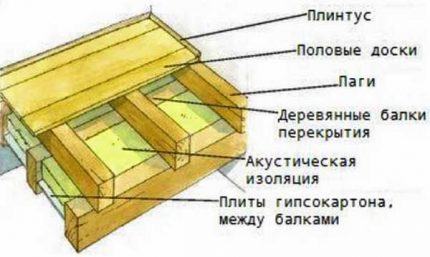
The most justified solution is to add beams under the floor so that plumbing can be installed. To do this, you have to temporarily remove the flooring, but only this option guarantees the stability of the toilet.
Do not forget that the toilet is mounted near the sewer riser.
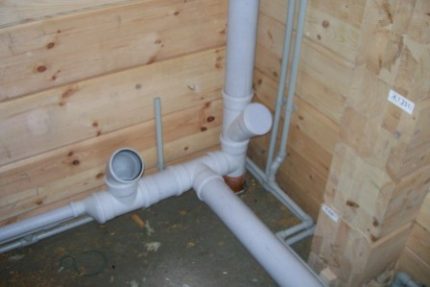
Even the upper floors are equipped with a vertical riser of the sewer pipe. The purpose of this segment is to create traction and improve drainage through pipes. Instead of a fan riser, a check valve is often installed.
Board Mounting Preparation
To install plumbing on a wooden floor, you need to prepare. First of all, choose the right toilet. Decide that, in addition to the plumbing fixture itself, you will need and purchase all the missing materials and tools. Among other things, if the installation will be carried out using taffeta, you also need to take care of it.
Choosing a toilet - which look is better
Choosing a toilet is not such a simple task as it seems. Especially when it comes to installing plumbing on a wooden floor in a country house. First of all, you need to have on hand a sewer wiring project with an indication of the height of the pipe and its diameter. This will help you choose the right model.
Then choose from the proposed varieties, depending on the location of the sewer pipe:
- with horizontal outlet;
- with release at an angle;
- vertically oriented.
Horizontal release. They are represented in our plumbing market in the largest selection. This option of supplying the device to the pipe is optimal. The minimum number of fittings is used, and the probability of an error during installation is reduced to zero.
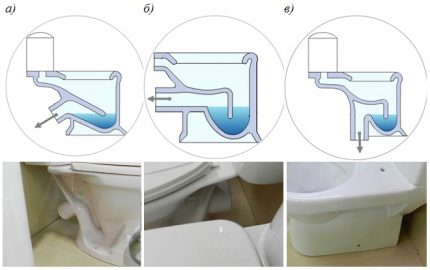
Angled Release. Such toilets are less popular. It is highly likely that when installed on a wooden floor, the height of the tie-in point in the sewer pipe will be higher than the discharge of the toilet. In this case, you have to think about the elevation for plumbing.
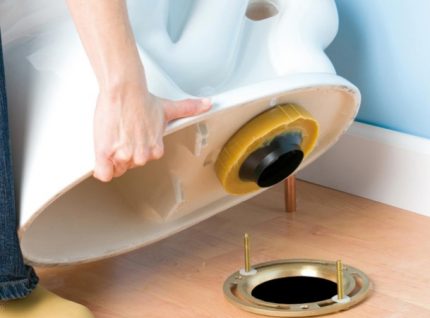
Vertical toilets in our homes you can hardly find it. Although they are in great demand abroad, for example, in the USA. The bottom line is that the issue is directed strictly down. The insert is carried out under the floor, as well as the laying of all communications.
More information about the different types of plumbing and the features of the choice of toilet in the articles:
- Types of toilets by technical specifications and design
- How to choose the right toilet: what to look before buying + manufacturers overview
Taffeta - what is it and whether it is needed during installation
Taffeta is a wooden stand that is used when installing a toilet on a wooden floor. Make it from a piece of a thick board. The thickness of the taffeta can be 20-30 mm. So that the wood does not rot from high humidity in the toilet, it is treated with drying oil.
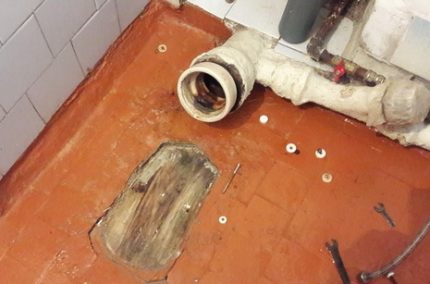
Lacking a high-quality power tool for drilling holes in the concrete floor, Soviet builders were forced to get out and resort to similar methods, especially in conditions of high rates of construction of typical high-rise buildings.

Now for installing the toilet on concrete, taffeta is not used. There are modern rotary hammers that eliminate this need. But in wooden houses in private construction, the use of such an element of installation work is still justified.
Taffeta is cut along the contour of the base of the plumbing fixture and mounted on a wooden floor flush with the surface.
Purchasing supplies and tools
To carry out a full installation of the toilet on a wooden floor, you need to prepare the following materials:
- mounting kit;
- screwdriver;
- screwdriver;
- drill;
- hammer;
- building level;
- corrugation;
- plumbing wrench.
The standard mounting kit that comes with the toilet is not suitable for mounting on a wooden floor. The screws and dowels that enter it are used to install plumbing on a concrete floor.
A soft tree prone to cracking cannot guarantee a firm hold. For wood floors use long wood screws.
A drill is needed for drilling holes for screws, a screwdriver or a screwdriver - for tightening screws. The construction level is necessary so that the toilet bowl is level, perpendicular to the floor and does not deviate.
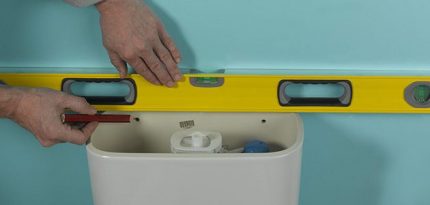
To connect plumbing to the water supply you will need a plumbing wrench. The toilet is led to the sewer using a corrugated pipe. Being flexible and pliable, the corrugation is well suited for installing plumbing with both horizontal and oblique release on a wooden floor.
Installation Process - Three Options
Installation on a wooden floor can be carried out by the following methods:
- on screws;
- on glue;
- on taffeta.
Find out the installation procedure in all three ways and choose the one that suits your needs.
On screws - the traditional method
On the screws, the toilet is mounted in a certain order. First of all, you should make sure that in the place chosen for installation, under the sheet floor covering, there are beams and their position coincides with the attachment points.
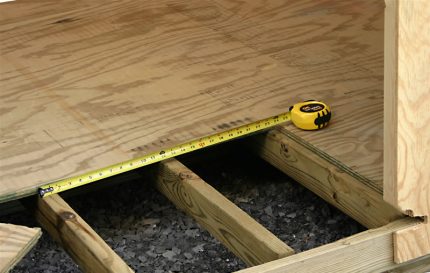
Then you need to put the toilet in the future place, circle its outline with a simple pencil and mark the places for the screws. After that, you can again remove the toilet and drill holes on the marks.
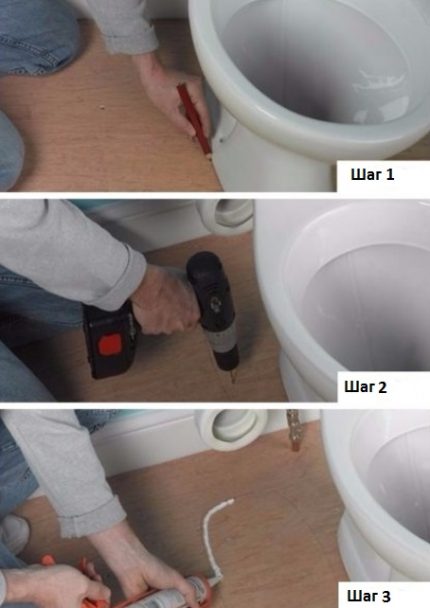
The next step will be the direct installation of the plumbing fixture in place and screwing the screws into the drilled holes. In order not to damage the plumbing cover, it is better to use special plastic washers. The set of fasteners for the toilet includes plugs that hide the heads of the screws.
Glue - an alternative to using a drill
Installation on glue is the most gentle method. In this case, you will not need to drill any holes and spoil the flooring. The toilet is simply glued along the contour with liquid nails, silicone sealant or epoxy.
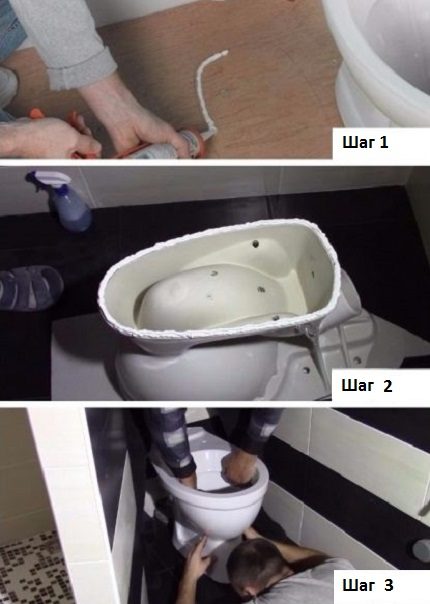
First of all, you should prepare the surface. The tree is thoroughly degreased, if there is a varnish coating, it is treated a little with sandpaper for better adhesion. The ceramic base of the toilet bowl is also treated with degreasing agents: solvent or alcohol.
Glue for attaching plumbing to a wooden floor can be prepared with your own hands.
The composition includes the following components:
- epoxy resin;
- solvent;
- cement;
- hardener.
As for the proportion, then for 50 g of epoxy you need to take 10 g of solvent, 100 g of cement and 15 g of hardener. First, the resin must be heated in a container of suitable size. The optimum temperature at which the reaction will take place in the best way is 50 ° C.
Solvent and hardener are added to the hot epoxy resin, the cement is thoroughly kneaded and added.

Put the toilet on a wooden floor, draw a pencil around the base. Then apply a little adhesive mixture along the contour. Also, the epoxy compound must be applied to the base of the plumbing.
The layer of substance should be at least 4-5 mm. The total setting area should be about 20 square meters. see, otherwise the glue may not hold the heavy toilet.

Replace the plumbing fixture. Pay attention to the coincidence of the base contour and the discharge of the sewer pipe. Press firmly on the toilet seat so that the excess mixture comes out.
Immediately, without waiting for drying, remove excess with a rag. Leave the toilet for 12 hours. After this time, you can start installing the tank and connecting communications.
Grandfather method - use taffeta
Installing a toilet on a taffeta is often used in situations where you need to mount on a wooden floor. A hole should be cut out in the floor to follow the outline of the plumbing fixture. Then the hole is poured with a cement screed, into which the prepared, processed taffeta is immersed.
Alternatively, a rubber backing can be used. A contour is cut out of a thick sheet (from 10 mm) and used in the same way as a wooden element. The advantage of rubber is its resistance to humid environments.Over time, unlike wood, rubber will not rot or dry out.
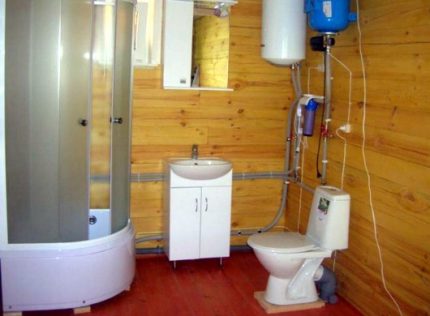
The stand needs to be pressed a little so that its upper edge is flush with the surface of the floor. For better fixation, nails are staggered at the bottom of a wooden board.
After the cement has hardened, the toilet is installed using screws, as in the first described installation method. Drill holes in the mounting points. They put the plumbing and screw the screws into the holes with a screwdriver. The heads are closed with plugs.
Construction of a country toilet with a toilet
A comfortable sanitary facility with a convenient toilet can be built on a summer cottage. It is better to connect it to a plastic storage tank or to a brick cesspool with plastered walls. The main thing is to make a sufficiently reliable ceiling, which serves as the basis for installing the toilet.
Tank installation and connection to communications
When the bowl is installed on a wooden floor, the time comes to install the drain tank and connect the entire structure to the communications. Separately connect sewer pipes and water supply.Detailed instructions and the procedure for further actions will help to make everything right.
How to install a drain tank on the toilet
When the toilet bowl is firmly installed and level on the wooden floor, proceed to installation of a drain tank. The installation process resembles a simple constructor. There are mounting holes in the bottom of the tank. It is enough to connect them with the holes on the toilet itself and fix it with the bolts that come with the kit.
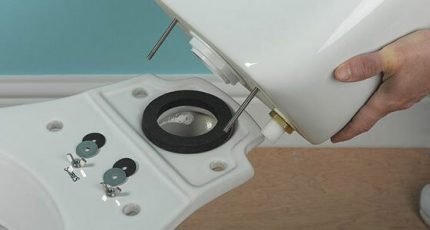
Before putting the tank, it must be assembled. The drain mechanism included in the package is assembled, according to the instructions, and the fitting is placed in a special hole in the bottom of the tank. Then, after fixing the ceramic part, water pipes are supplied.
How to connect the toilet to the water supply and sewerage
Traditionally, the toilet is first connected to the sewer. If you start by connecting the water supply, then it will be problematic to check the installation: it will not be possible to let water in before the sewer pipe is brought up.
To connect the toilet on a wooden floor most often use a corrugated adapter or a hard plastic element with a cuff.
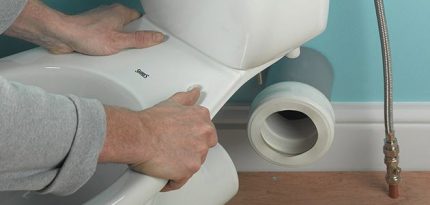
Connection begins with the fact that they insert the end of the corrugation into the sewer pipe. The junction is thoroughly treated with silicone. The free end is connected to the toilet outlet. All joints pass again with silicone sealant.
To check, pour a bucket of water into the bowl. At this point, it is important to carefully inspect all compounds for leaks.

A rigid eccentric element for connecting the toilet requires an accurate fit of the pipe, tee and outlet of the toilet. It is imperative that rubber o-rings be inserted into pipe and pipe bells. All connections are lubricated with sealant for reliability.
It is advisable to fix the toilet on a wooden floor after summing up the drain, after installation it will be more difficult to do. When the sewerage is connected, you can finally screw the screws and process the junction of the base of the toilet with the floor sealant.
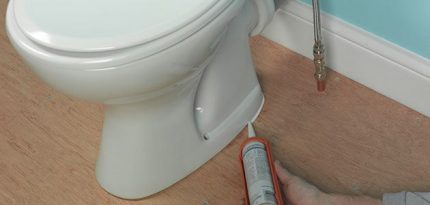
To bring water to the drain tank, to a pre-mounted outlet of the water pipe, a flexible nylon-reinforced hose is connected. The toilet must be equipped with a separate ball valve to turn off the water supply.
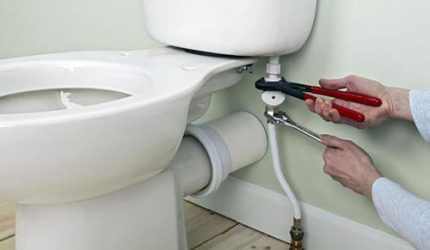
Connect all the elements of the water supply system. At joints, use gaskets, threaded sealing tape or silicone sealant.
Water leaks happen much more often than sewers. A big problem - dripping tank. Up to 200 liters of clean tap water can go into a pipe per day. So imperceptibly you will use up a cube of water in 5 days only because the installation of the tank and the connection of the toilet to the water supply were not carried out correctly.
Conclusions and useful video on the topic
Without a detailed video instruction to carry out installation work, without having the experience of such installations, is risky. See how professionals recommend installing toilets on a wooden floor, and gain experience.With such advice, the likelihood that something will go wrong tends to a minimum.
How to install a toilet on a wooden floor:
Temporary installation of a toilet in a wooden house:
If you have to install a toilet on a wooden floor in the country or in a country house, now this will not be a problem for you. Recommendations for choosing a toilet and several working instructions for installation in different ways will be useful not only to beginners, but also experienced builders.
Share with your readers your experience with installing a toilet on a wooden floor. Please leave comments on the article and ask your questions. The feedback block is located below.

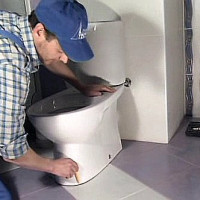 How to install a toilet on a tile with your own hands: step-by-step instruction + installation features
How to install a toilet on a tile with your own hands: step-by-step instruction + installation features 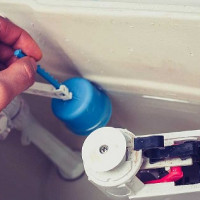 How to repair the toilet with your own hands: analysis of common breakdowns
How to repair the toilet with your own hands: analysis of common breakdowns 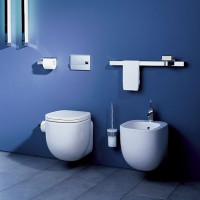 Installation of a toilet bowl installation: detailed installation instructions for a wall mounted toilet bowl
Installation of a toilet bowl installation: detailed installation instructions for a wall mounted toilet bowl  Lid for toilet: varieties, selection tips, installation instructions
Lid for toilet: varieties, selection tips, installation instructions 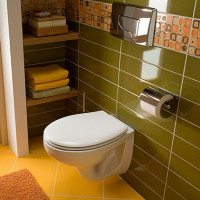 Installation of a hanging toilet: we analyze the nuances of installation technology
Installation of a hanging toilet: we analyze the nuances of installation technology 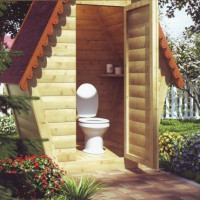 Country toilet: an overview of the types of garden models for a country toilet and the features of their installation
Country toilet: an overview of the types of garden models for a country toilet and the features of their installation  How much does it cost to connect gas to a private house: the price of organizing gas supply
How much does it cost to connect gas to a private house: the price of organizing gas supply  The best washing machines with dryer: model rating and customer tips
The best washing machines with dryer: model rating and customer tips  What is the color temperature of light and the nuances of choosing the temperature of the lamps to suit your needs
What is the color temperature of light and the nuances of choosing the temperature of the lamps to suit your needs  Replacement of a geyser in an apartment: replacement paperwork + basic norms and requirements
Replacement of a geyser in an apartment: replacement paperwork + basic norms and requirements
In the country, this situation was. My brother and I put a toilet on a tree. They took it most simply with a horizontal outlet, so as not to fit under the pipe. In fact, installation is not much more complicated than concrete. The difference is in taffeta and wood screws, and so everything is as usual - by the level to make sure that the toilet is standing straight ahead! If you already had experience with the installation, then it is not very difficult.
Parents have their own house in the village. Construction work was completed in the summer, so the sewage system was carried out recently. They decided to install the plumbing on their own, without calling the masters. After installing the toilet, they found that when flushing, water flows under it. I had to go through the sealant at the place of contact with the floor. In general, the problem was resolved. The main thing is not to forget to tighten the toilet so that it does not walk on the floor.